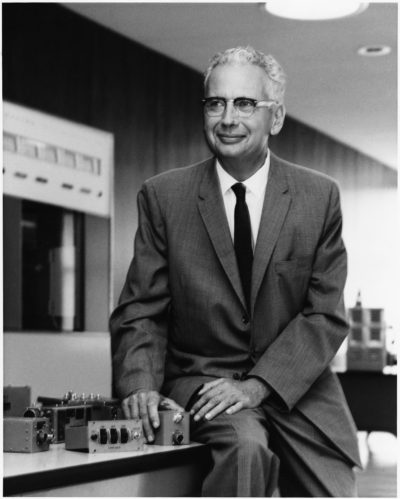By Annette Juergens Busbee

Arthur A. Collins, circa 1965, sits next to several radios designed and manufactured by his company.
In 1925, Americans were transfixed by news from the MacMillan Arctic Expedition. The polar quest was led by veteran explorer Donald B. MacMillan who was assisted by U.S. Navy Lt. Cmdr. Richard E. Byrd. The highly publicized exploration was sponsored largely by the National Geographic Society with support from the U.S. Navy.
Not only did the stories from the expedition capture the imagination of the country, but Americans would soon learn another fact that would equally amaze them. Much of the news they were reading was being transmitted from the subarctic of northern Greenland to a ham radio station operated by a 15-year old Iowan.
That young man was Arthur Collins. He was communicating with the expedition’s radio operator, John Reinartz, from the home station Collins had designed and built in the attic of his family’s Cedar Rapids home.
Reinartz and Collins had met and become friends through amateur radio communications. Radio was in its infancy in the 1920s, and the two shared a keen interest in radio wave propagation. At the time, it was believed that within the radio spectrum only longer waves were propagated along the earth’s surface with increasing distance at night.
However, Reinartz and Collins discovered that an atmospheric “skip” occurred in the shorter wavelengths relegated to amateur radio operators. And the “skip” occurred during the daytime over long distances. With that knowledge, the two were able to maintain reliable communication throughout the expedition — something the U.S. Navy, relying on longer wavelengths, could not do.
That accomplishment gave the Cedar Rapids high schooler local and national recognition. The attention was not welcomed by the shy teen, however, and he would shun the spotlight throughout his career. But, the event set the stage for him to pursue a lifetime of significant technological achievements that affects the daily lives of millions of people today.
TO READ MORE ABOUT THIS STORY AND OTHER FASCINATING STORIES ABOUT IOWA HISTORY, subscribe to Iowa History Journal. You can also purchase back issues at the store.
